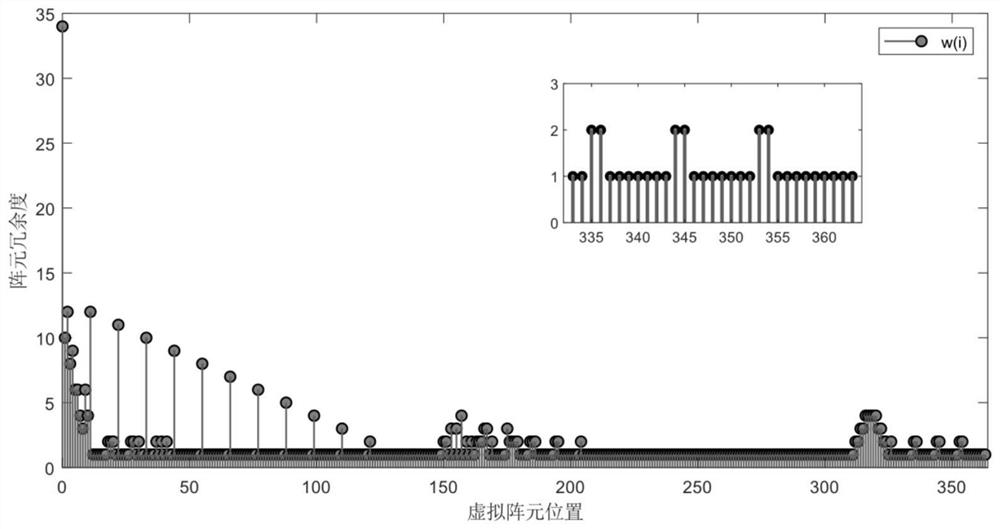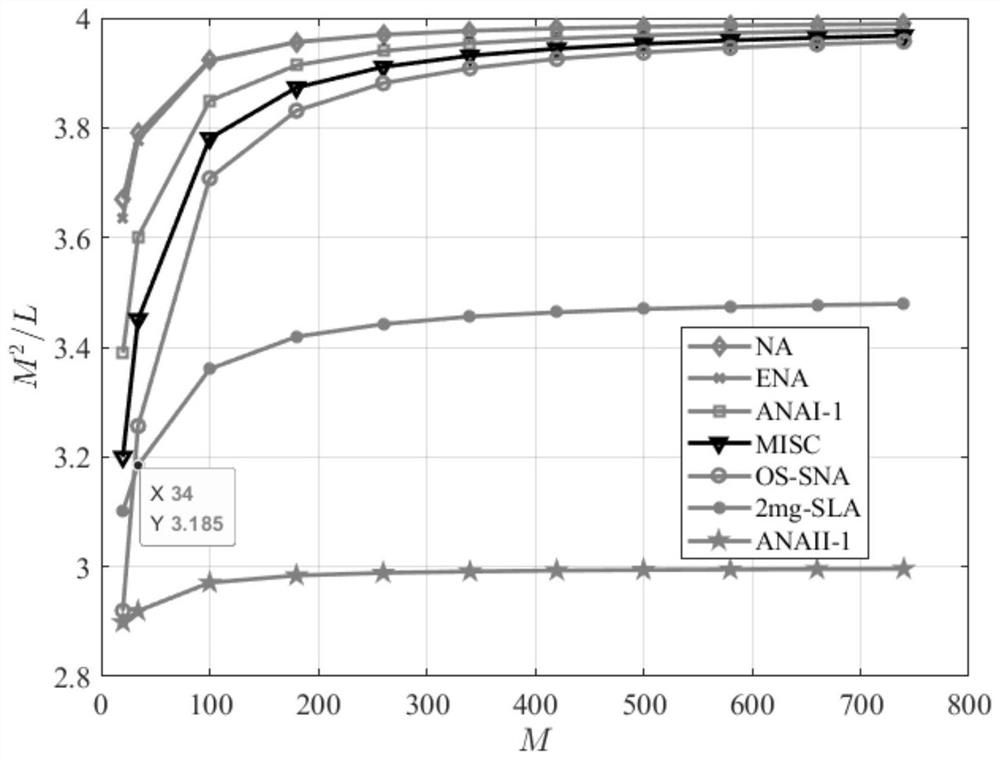Sparse array arrangement method for direction of arrival estimation
A direction-of-arrival estimation and sparse array technology, which is applied to direction finders using radio waves, radio wave direction/deviation determination systems, antenna arrays, etc., can solve problems such as gaps, and achieve the effect of improving accuracy and resolution
- Summary
- Abstract
- Description
- Claims
- Application Information
AI Technical Summary
Problems solved by technology
Method used
Image
Examples
Embodiment 1
[0064] The purpose of this example is to verify that the sparse array proposed in the present invention has a larger aperture and a higher degree of spatial freedom under the same array element compared with the other five arrays, and is closer to the performance of ANAII-1. It is supplemented that, for M array elements, a uniform linear array with a spacing of half a wavelength can perform direction finding on M-1 source signals at the same time, and M-1 is the size of the spatial degree of freedom. The definition of the linear array aperture is the maximum array element interval, which is equal to (M-1)×d in the above uniform linear array, and we find that the difference between the two is only unit d in value. For sparse arrays, the spatial degrees of freedom are determined by the corresponding virtual array. The array proposed in this paper and all the comparison arrays, the physical arrays are all sparse arrays. After virtual change, a virtual array with the same aperture...
Embodiment 2
[0070] The purpose of this example is to verify that the array proposed in the present invention has better direction finding performance under the same array element compared with the other five arrays, and is closer to the performance of ANAII-1. It is assumed that there are 61 uncorrelated sources in the space incident on the above sparse array, and the incident angles are uniformly distributed between -60° and 60°. The signal-to-noise ratio of the incident signal was changed from -20dB to 20dB, the step size was 2dB, there were 21 points in total, the sampling number was K=1000, and 100 Monte Carlo experiments were carried out.
[0071] The optimal parameter settings and apertures of each array in the case of 34 elements are as follows:
[0072]
[0073] The root mean square error of seven sparse arrays for DOA estimation varies with the signal-to-noise ratio as follows: Figure 4 shown. It can be seen that the SNR of all arrays is between -20dB and 0dB. With the incr...
Embodiment 3
[0075] The purpose of this example is to verify that the array proposed in the present invention has better direction finding performance under the same array element compared with the other five arrays, and is closer to the performance of ANAII-1. It is assumed that there are 61 uncorrelated sources in the space incident on the above sparse array, and the incident angles are uniformly distributed between -60° and 60°. The signal-to-noise ratio of the incident signal is 0dB, and 100 Monte Carlo experiments are carried out. The variation of the sampling number is set to non-uniform sampling, and the sampling is performed in small steps and multi-sampling in the interval of low sampling number, and sampling in large step in the interval of high sampling number. method, the final set of sampling numbers is:
[0076] {50, 100, 150, 200, 250, 300, 400, 600, 800, 1000, 1300, 1600, 1900, 2400, 2800}, a total of 15 points.
[0077] The parameter settings of each array are the same as...
PUM
 Login to View More
Login to View More Abstract
Description
Claims
Application Information
 Login to View More
Login to View More - R&D
- Intellectual Property
- Life Sciences
- Materials
- Tech Scout
- Unparalleled Data Quality
- Higher Quality Content
- 60% Fewer Hallucinations
Browse by: Latest US Patents, China's latest patents, Technical Efficacy Thesaurus, Application Domain, Technology Topic, Popular Technical Reports.
© 2025 PatSnap. All rights reserved.Legal|Privacy policy|Modern Slavery Act Transparency Statement|Sitemap|About US| Contact US: help@patsnap.com



